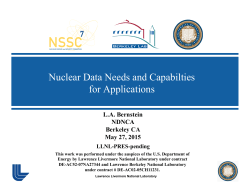
nuclear disarmament - Belfer Center for Science and International
Overcoming Challenges of Non-Nuclear Weapon States Involvement in Disarmament Verification Malte Göttsche NPT/CONF.2010/50: “The Conference recognizes that nuclear disarmament and achieving the peace and security of a world without nuclear weapons will require openness and cooperation, and affirms the importance of enhanced confidence through increased transparency and effective verification” Verification The Non-Proliferation Treaty Each nuclear-weapon State Party to the Treaty undertakes not to transfer to any recipient whatsoever nuclear weapons […] and not in any way to assist, encourage, or induce any nonnuclear-weapon State to manufacture or otherwise acquire nuclear weapons [...] II Each non-nuclear-weapon State Party to the Treaty undertakes not to receive the transfer from any transferor whatsoever of nuclear weapons […]; not to manufacture or otherwise acquire nuclear weapons and not to seek or receive any assistance in the manufacture of nuclear weapons [...] VI Each of the Parties to the Treaty undertakes to pursue negotiations in good faith on effective measures relating to cessation of the nuclear arms race at an early date and to nuclear disarmament, and on a treaty on general and complete disarmament under strict and effective international control. Involving Non-Nuclear Weapon States (NNWS) in an International Cooperation Effective Verification: Technical Methods Warhead and warhead component authentication I NPT/CONF.2010/50 Action 19: “All States agree on the importance of supporting cooperation among Governments, the United Nations, other international and regional organizations and civil society aimed at increasing confidence, improving transparency and developing efficient verification capabilities related to nuclear disarmament.” Purpose NNWS obligations: IAEA Safeguards NWS obligations: no multilateral verification to determine if items declared to be warheads and warhead components are, in fact, that Implemen- measurements behind an information barrier (e.g. tation gamma and neutron measurements and the attribute or template approach) ●Joint development without discussing sensitive Issues information, authentication and certification ●Inspector cannot review measurements → high reliability required, not always achieved yet ●Difficulty with uranium (research in Hamburg) Why include non-nuclear weapon states? The NPT text strongly suggests their participation ● Global disarmament requires NNWS confidence in Art. VI fulfillment, otherwise not all might adhere to NPT in long-term ● How can NNWS gain confidence? ● NNWS only gain confidence from verification activities if they understand the effectiveness of procedures and equipment NNWS must be actively involved! The Disarmament Process DISMANTLEMENT: SEVERELY RESTRICTED ACCESS US/Russia: New START Treaty verification NONNUCLEAR COMPONENTS ● U / Pu CONVERSION OR DISPOSITION Unique identification Purpose Continuity of knowledge Verified baseline declarations of inventories ● Verified declarations of inventory changes ● Verification of warhead dismantlement ● Verification of fissile materials malte.goettsche@physik.uni-hamburg.de Carl Friedrich von Weizsäcker Centre for Science and Peace Reseach, University of Hamburg, Beim Schlump 83, 20144 Hamburg, Germany ● Implemen- ●record intrinsic fingerprint-like feature on item ●safe and secure tamper-resistant tag (not serial tation numbers) → research and collaboration need! To obtain confidence in disarmament: ● to prevent miscounting warheads (e.g. double) to keep continuous track of treaty limited items (uninterrupted thread of evidence over time) Implemen- remote monitoring (e.g. cameras), tampertation indicating devices (e.g. seals) → managed access issue requires research and collaboration, e.g. UKNI ● Purpose ● Domestic development of capacities (education, research) is essential for independent assessments → initiating and supporting programs in academic and other research institutions such as in Hamburg (natural sciences, engineering, policy) Multilateral cooperation: Joint research across institutions and countries, in particular joint technology development and joint technical exercises → reproducable research, peer-reviewed publications facilitate effective dialogue Examples: UK-Norway-Initiative, (Trilateral Initiative), Nuclear Threat Initiative's Verification Pilot Project, US-initiated International Partnership for Nuclear Disarmament Verification NPT Art. I/II: all partners must be careful not to share sensitive information declassification of certain non-proliferative information could facilitate the process and increase confidence from verification References Nuclear Threat Initiative, Innovating Verification: New Tools & New Actors to Reduce Nuclear Risks, Verifying Baseline Declarations of Nuclear Warheads and Materials, Washington, 2014. Nuclear Threat Initiative, Innovating Verification: New Tools & New Actors to Reduce Nuclear Risks, Building Global Capacity, Washington, 2014. UK/Norway Collaboration, The United Kingdom-Norway Initiative on the Verification of Nuclear Warhead Dismantlement, NPT PrepCom, Vienna, 2012. US Department of State, Fact Sheet: An International Partnership for Nuclear Disarmament Verification, December 2014, see http://www.state.gov/t/avc/rls/234680.htm
© Copyright 2025
















